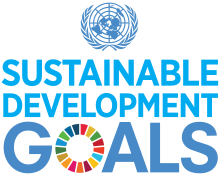
Sustainable Development Goals
United Nations' 17 global goals for 2030 / From Wikipedia, the free encyclopedia
Dear Wikiwand AI, let's keep it short by simply answering these key questions:
Can you list the top facts and stats about Sustainable Development Goals?
Summarize this article for a 10 years old
The Sustainable Development Goals (SDGs) or Global Goals are a collection of seventeen interlinked objectives designed to serve as a "shared blueprint for peace and prosperity for people and the planet, now and into the future."[1][2][3] The short titles of the 17 SDGs are: No poverty (SDG 1), Zero hunger (SDG 2), Good health and well-being (SDG 3), Quality education (SDG 4), Gender equality (SDG 5), Clean water and sanitation (SDG 6), Affordable and clean energy (SDG 7), Decent work and economic growth (SDG 8), Industry, innovation and infrastructure (SDG 9), Reduced inequalities (SDG 10), Sustainable cities and communities (SDG 11), Responsible consumption and production (SDG 12), Climate action (SDG 13), Life below water (SDG 14), Life on land (SDG 15), Peace, justice, and strong institutions (SDG 16), Partnerships for the goals (SDG 17).
| Sustainable Development Goals | |
|---|---|
 | |
| Mission statement | "A shared blueprint for peace and prosperity for people and the planet, now and into the future"[1] |
| Type of project | Non-Profit |
| Location | Global |
| Founder | United Nations |
| Established | 2015 |
| Website | sdgs |
The SDGs emphasize the interconnected environmental, social and economic aspects of sustainable development by putting sustainability at their center.[4][5]
In 2015, the United Nations General Assembly (UNGA) created the SDGs as part of the Post-2015 Development Agenda. This agenda sought to design a new global development framework, replacing the Millennium Development Goals, which were completed that same year.[6] These goals were formally articulated and adopted in a UNGA resolution known as the 2030 Agenda, often informally referred to as Agenda 2030.[7] On 6 July 2017, the SDGs were made more actionable by a UNGA resolution that identifies specific targets for each goal and provides indicators to measure progress.[8] Most targets are to be achieved by 2030, although some have no end date.[9]
There are cross-cutting issues and synergies between the different goals; for example, for SDG 13 on climate action, the IPCC sees robust synergies with SDGs 3 (health), 7 (clean energy), 11 (cities and communities), 12 (responsible consumption and production) and 14 (oceans).[10][11]: 70 On the other hand, critics and observers have also identified trade-offs between the goals,[11]: 67 such as between ending hunger and promoting environmental sustainability.[12]: 26 Furthermore, concerns have arisen over the high number of goals (compared to the eight Millennium Development Goals), leading to compounded trade-offs, a weak emphasis on environmental sustainability, and difficulties tracking qualitative indicators.
The SDGs are monitored by the UN (United Nations) High-Level Political Forum on Sustainable Development (HLPF), an annual forum held under the auspices of the United Nations Economic and Social Council. However, the HLPF comes with its own set of problems due to a lack of political leadership and divergent national interests.[13]: 206 To facilitate monitoring of progress on SDG implementation, the online SDG Tracker was launched in June 2018 to present all available data across all indicators.[14] The COVID-19 pandemic had serious negative impacts on all 17 SDGs in 2020.[15] A scientific assessment of the political impacts of the SDGs found in 2022 that the SDGs have only had limited transformative political impact thus far.[16] At the very least, they have affected the way actors understand and communicate about sustainable development.[16]